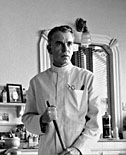
Movie Guru Rating:

Comment
on this review
| |

The Coen brothers find The Man Who Wasn't There.
by Lee Gardner
Like any good film geeks, Joel and Ethan Coen have a thing for the half-lit rooms and moral gray areas of film noir. The writing/directing/producing brothers made their first big splash with their indelible 1984 debut Blood Simple, a taut and brutal tale of betrayal, revenge, and blind coincidence that helped launch the neo-noir boom. And what is The Big Lebowski but a Raymond Chandler yarn played for laughs, with a stoned ex-hippie bowling nut in an Ecuadorian hoodie standing in for Philip Marlowe? Even their big commercial breakthrough, Fargo, is in many ways, just a noir set in white-out conditions.
With The Man Who Wasn't There, the Coens tackle a full-on period-noir pastiche, complete with petty schemes gone awry, adultery, blackmail, murder, and the electric chair waiting at the end, all brought to the screen in silky black and white. And even though one of the Coens' other enduring hallmarks—a near-maddening refusal to play even their best material straight—threatens to sink it in the third act, TMWWT is their most strangely compelling movie in years.
"Me, I don't talk much," Ed Crane (Billy Bob Thornton) monotones early on in the film's running voice-over. No kidding. The Coens' protagonist is a small-town barber of remarkably few words. But Ed is more than just quiet; he is, as the title indicates, more an absence than a presence in the lives of those around him. There's a running gag built around the fact that the other characters barely remember him, much less his name, when they run into him. And Ed is detached in more than manner. When his outgoing wife Doris (Frances McDormand) invites her boss, Big Jim (James Gandolfini), and his wife Ann (Katherine Borowitz) to dinner, Ed informs the audience via monologue that he and Doris are "entertaining"; Thornton's uncomprehending reading of the word gives it the same alien ring as if he'd said "colonoscopy." And when Ed figures out that Doris and Big Jim are having an affair, he lights yet another cigarette and allows, "It's a free country."
But Ed is not without his dreams and passions, muted though they may be. A shifty businessman (Jon Polito in a deliciously seedy turn) tempts Ed into a venal conspiracy with a classic James M. Cain-style low-ball aspiration—the chance to become a dry cleaner. Ed even approaches the threshold of being visibly moved when he encounters a nubile teenager named Birdy (Scarlet Johansson) playing Beethoven; he shows such sincere interest in furthering her concertizing career that she comically mistakes him for "an enthusiast." Soon, however, Ed's actions get him and all those around him caught up in the gears of fate, in classic noir style.
Speaking of classic, no self-respecting film geek should miss seeing Thornton and company scurry about their mundane destinies on the big screen in glorious black and white. The Coens and their stalwart cinematographer, Roger Deakins, filmed TMWWT on a color negative and then printed on a high-contrast B&W stock usually used for credits. The resulting images are as elegant and striking as the setting and circumstances are grubby and run-of-the-mill; it seems possible that the Coens made this movie just so they could film dust on a spinning barber pole, hair clippings falling on tile, or a lady's veil backlit by a streetlight and have it look this beautiful.
While the Coens' little company of longtime favorite actors (including McDormand, Polito, Michael Badalucco, and the marvelous Tony Shalhoub) tear into the script's boffo retro with zeal, the movie revolves entirely around Thornton's title void. An unfortunate late-breaking sci-fi theme proves a major, almost insurmountable distraction, but Thornton, channeling a more urbane version of Sling Blade's mineral-like Karl Childers, somehow gets poignance out of cold fish Ed. When his running monologue reveals that he feels like "a ghost walking down the street," it's possible to feel a pang for him, even though he never shows any emotion or regret over the film's events. Here is a man who has disappeared from ordinary human life on several levels and doesn't know how it happened. Viewed through that prism, there's more to The Man Who Wasn't There than meets the eye.

November 29, 2001 * Vol. 11, No. 48
© 2000 Metro Pulse
|